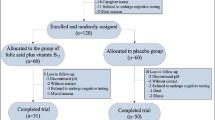Abstract
Recently, combination therapy involving cholinesterase (ChE) inhibitor with other neuroprotective agents has shown better desirable effect in the management/prevention of dementia but limited information is available on their effect with dietary polyphenols. Hence, this study sought to assess the combined pretreatment effect of curcumin, the major polyphenolic compound of turmeric (Curcuma longa) rhizomes, with donepezil, a cholinesterase inhibitor, on cognitive function in scopolamine-induced memory impairment in rats. Rats were pretreated with curcumin (50 mg/kg) and/or donepezil (2.5 mg/kg) via oral administration (p.o.) for seven successive days. Dementia was induced at the end of the treatment period by a single injection of scopolamine (1 mg/kg) via intraperitoneal (i.p.) administration. Thereafter, the changes in spatial and episodic memory were conducted; then, the estimation of some biochemical parameters associated with cognitive function was determined. Scopolamine-treated rats showed impaired learning and memory and increased activities of acetylcholinesterase (AChE) and butyrylcholinesterase (BuChE), adenosine deaminase (ADA), and lipid peroxidation with a concomitant decreased in levels of nitric oxide (NO) and reduced glutathione (GSH), superoxide dismutase (SOD), and catalase activities when compared with control. However, combination of curcumin and donepezil improves learning and memory activity associated with inhibitory effect on AChE, BuChE, and ADA activities as compared to control. In addition, combined pretreatment significantly decreased lipid peroxidation and increased levels of NO and antioxidant status when compared with scopolamine-treated rats. This finding supports the concept that the combination strategy might be an alternative therapy in the management/prevention of neurological disorders. Thus, the observed anti-amnestic effect could be linked to their inhibitory effect on key enzyme of cholinergic system associated with memory function.





Similar content being viewed by others
References
Adeniyi PA, Ishola AO, Laoye BJ, Olatunji BP, Bankole OO, Shallie PD, Ogundele OM (2016) Neural and behavioural changes in male periadolescent mice after prolonged nicotine-MDMA treatment. Metab Brain Dis 30:15
Akinyemi AJ, Okonkwo PK, Faboya OA, Onikanni SA, Fadaka A, Olayide I, Akinyemi EO, Oboh G (2016a) Curcumin improves episodic memory in cadmium induced memory impairment through inhibition of acetylcholinesterase and adenosine deaminase activities in a rat model. Metab Brain Dis. doi:10.1007/s11011-016-9887-x
Akinyemi AJ, Thome GR, Morsch VM, Stefanello N, da Costa P, Cardoso A, Goularte JF, Bello-Klein A, Akindahunsi AA, Oboh G, Schetinger MRC (2016b) Effect of dietary supplementation of ginger and turmeric rhizomes on ectonucleotidases, adenosine deaminase and acetylcholinesterase activities in synaptosomes from the cerebral cortex of hypertensive rats. J Appl Biomed 14:59–70
Amic D, Davidovic-Amic D, Beslo D, Trinajstic N (2003) Structure radical scavenging activity relationship of flavonoids. Croatia Chem Acta 76:55–61
Anand R, Gill KD, Mahdi AA (2014) Therapeutics of Alzheimer’s disease: past, present and future. Neuropharmacol 76:27–50
Boutajangout A, Wisniewski T (2014) Tau based therapeutic approaches for Alzheimer’s disease. Gerontol 60(5):381–385
Breunig JJ, Guillot-Sestier MV, Town T (2013) Brain injury, neuroinflammation and Alzheimer’s disease. Front Aging Neurosci 5:26
Brouet I, Ohshima H (1995) Curcumin, an anti-tumour promoter and anti-inflammatory agent, inhibits induction of nitric oxide synthase in activated macrophages. Biochem Biophys. Res Commun 206:533–540
Burnstock G (2006) Purinergic signalling. Br J Pharmacol 147:172–181
Burnstock G, Fredholm BB, Verkhratsky A (2011) Adenosine and ATP receptors in the brain. Curr Top Med Chem 11:973–1011
Cheng IF, Breen K (2000) On the ability of four flavonoids, baicilein, luteolin, naringenin, and quercetin, to suppress the Fenton reaction of the iron-ATP complex. Biometals 13:77–83
Clairborne A (1995) Catalase activity. In: Greewald AR (ed) Handbook of methods for oxygen radical research. CRC Press, Boca Raton, USA, pp 237–242
Costa P, Goncalves JF, Baldissarelli J, Mann TR, Abdalla FH, Fiorenza AM, da Rosa MM, Carvalho FB, Gutierres JM, de Andrade CM, Rubin MA, Schetinger MRC, Morschet VM (2015) Curcumin attenuates memory deficits and the impairment of cholinergic and purinergic signaling in rats chronically exposed to cadmium. Environ Toxicol. doi:10.1002/tox.22213
de Bruin NM, Prickaerts J, Lange JH, Akkerman S, Andriambeloson E, deHaan M, Wijnen J, van Drimmelen M, Hissink E, Heijink L, Kruse CG (2010) SLV330, a cannabinoid CB1 receptor antagonist, ameliorates deficits in the T-maze, object recognition and social recognition tasks in rodents. Neurobiol Learn Mem 93:522–531
Deiana S, Harrington CR, Wischik CM, Riedel G (2009) Methylthioninium chloride reverses cognitive deficits induced by scopolamine: comparison with rivastigmine. Psychopharmacol 202:53–65
Dooley M, Lamb HM (2000) Donepezil: a review of its use in Alzheimer’s disease. Drugs Aging 16:199–226
Elger CE, Helmstaedter C, Kurthen M (2004) Chronic epilepsy and cognition. Lancet Neurol 3:663–672
Ellman GL (1959) Tissue sulfhydryl groups. Arch Biochem Biophys 82:70–77
Ellman GL, Courtney KD, Andres V, Jr Featherstone RM (1961) A new and rapid colorimetric determination of acetylcholinesterase activity. Biochem Pharmacol 7:88–95
Fukao M, Hattori Y, Kanno M, Sakuma I, Kitabatake A (1997) Sources of Ca2+ in relation to generation of acetylcholine-induced endothelium-dependent hyperpolarization in rat mesenteric artery. Br J Pharmacol 120:1328–1334
Garcia-Alloza M, Borrelli LA, Rozkalne A, Hyman BT, Bacskai BJ (2007) Curcumin labels amyloid pathology in vivo, disrupts existing plaques and partially restores distorted neurites in an Alzheimer mouse model. J Neurochem 102:1095–1104
Garry PS, Ezra M, Rowland MJ, Westbrook J, Pattinson KTS (2015) The role of the nitric oxide pathway in brain injury and its treatment from bench to bedside. Exp Neurol 263:235–243
Garthwaite J, Boulton CL (1995) Nitric oxide signaling in the nervous system. Ann Rev Physiol 57:683–706
Goldman-Rakic PS, Castner SA, Svensson TH, Siever LJ, Williams GV (2004) Targeting the dopamine D1 receptor in schizophrenia: insights for cognitive dysfunction. Psychopharmacol 174:3–1
Goverdhan P, Sravanthi A, Mamatha T (2012) Neuroprotective effects of meloxicam and selegiline in scopolamine-induced cognitive impairment and oxidative stress. Int J Alzheimers Dis 2012:974013
Griffiths S, Scott H, Glover C, Bienenmann A, Ghorbel MT, Uney J (2008) Expression of long term depression underlies visual recognition memory. Neuron 58:186–194
Guisti G, Galanti B (1984) Colorimetric method. In: Bergmeyer HU (eds) Methods of enzymatic analysis, Verlag Chemie Weinheim, pp 315–323
Gupta A, Vij G, Sharma S, Tirkey N, Rishi P, Chopra K (2009) Curcumin, a polyphenolic antioxidant, attenuates chronic fatigue syndrome in murine water immersion stress model. Immunobiol 214:33–39
Gutierres JM, Carvalho FB, Schetinger MR, Rodrigues MV, Schmatz R, Pimentel VC, Vieira JM, Rosa MM, Marisco P, Ribeiro DA, Leal C, Rubin MA, Mazzanti CM, Spanevello RM (2012) Protective effects of anthocyanins on the ectonucleotidase activity in the impairment of memory induced by scopolamine in adult rats. Life Sci 91:1221–1228
Hamlin AS, Windels F, Boskovic Z, Sah P, Coulson EJ (2013) Lesions of the basal forebrain cholinergic system in mice disrupt idiothetic navigation. PLoS One 8:53472
Hashimoto T, Hatayama Y, Nakamichi K, Yoshida N (2014) Procognitive effect of AC-3933 in aged mice, and synergistic effect of combination with donepezil in scopolamine-treated mice. Eur J Pharmacol 745:123–128
Jaques JAS, Rezer JFP, Ruchel JB, Becker LV, Rosa CS, Souza VCG, Luz SCA, Gutierres JM, Goncalves JF, Morsch VM, Schetinger MRC, Leal DBR (2011) Lung and blood lymphocytes NTPDase and acetylcholinesterase activity in cigarette smoke-exposed rats treated with curcumin. Biom Prev Nutr 1:109–115
Jaques JAS, Rezer JFP, Carvalho FB, Rosa MM, Gutierres JM, Goncalves JF, Schmatz R, Bairros AV, Mazzanti CM, Rubin MA, Schetinger MRC, Leal DBR (2012) Curcumin protects against cigarette smoke-induced cognitive impairment and increased acetylcholinesterase activity in rats. Physiol Behav 106:664–669
Jeong EJ, Ma CJ, Lee KY, Kim SH, Sung SH, Kim YC (2009) KD-501, a standardized extract of Scrophularia buergeriana has both cognitive-enhancing and antioxidant activities in mice given scopolamine. J Ethnopharmacol 121:98–105
Jorge RE, Robinson RG (2011) Treatment of late-life depression: a role of non-invasive brain stimulation techniques. Int Rev Psych 23:437–444
Khalifa AE (2004) Pro-oxidant activity of zuclopenthixol in vivo: differential effect of the drug on brain oxidative status of scopolamine-treated rats. Hum Exp Toxicol 23:439–445
Klinkenberg I, Blokland A (2010) The validity of scopolamine as a pharmacological model for cognitive impairment: a review of animal behavioral studies. Neurosci Biobehav Rev 34:1307–1350
Kumar A, Dogra S, Prakash A (2009) Protective effect of curcumin (Curcuma longa), against aluminium toxicity: possible behavioral and biochemical alterations in rats. Behav Brain Res 205:384–390
Kwon SH, Kim HC, Lee SY, Jang CG (2009) Loganin improves learning and memory impairments induced by scopolamine in mice. Eur J Pharmacol 619:44–49
Ma QL, Yang F, Rosario ER, Ubeda OJ, Beech W, Gant DJ, Chen PP, Hudspeth B, Chen C, Zhao Y, Vinters HV, Frautschy SA, Cole GM (2009) Beta-amyloid oligomers induce phosphorylation of tau and inactivation of insulin receptor substrate via c-Jun N-terminal kinase signaling: suppression by omega-3 fatty acids and curcumin. J Neurosci 29:9078–9089
Marisco PC, Carvalho FB, Rosa MM, Girardi BA, Gutierres JM, Jaques JA, Salla APS, Pimentel VC, Schetinger MRC, Leal DBR, Mello CF, Rubin MA (2013) Piracetam prevents scopolamine-induced memory impairment and decrease of NTPDase, 5′-nucleotidase and adenosine deaminase activities. Neurochem Res 38:1704–1714
Miranda KM, Espay MG, Wink DA (2001) A rapid, simple spectrophotometric method for simultaneous detection of nitrate and nitrite. Nitric Oxide Biol Chem 5:62–71
Mishra S, Palanivelu K (2008) The effect of curcumin (turmeric) on Alzheimer’s disease: an overview. Ann Indian Acad Neurol 11(1):13–19
Misra HP, Fridovich I (1972) The role of superoxide anion in the autoxidation of epinephrine and a simple assay for superoxide dismutase. J Biol Chem 247:3170–3175
Nguyen MD, Salbu RL (2013) Donepezil 23 mg: a brief insight on efficacy and safety concerns. Consult Pharm 28:800–803
Ohkawa H, Ohishi N, Yagi K (1979) Assay for lipid peroxides in animal tissues by thiobarbituric acid reaction. Anal Biochem 95:351–358
Paul V, Ekambaram P (2011) Involvement of nitric oxide in learning and memory processes. Indian J Med Res 133:471–478
Paul V, Subramanian EH (2002) Evidence for an involvement of nitric oxide and raminibutyric acid in the anticonvulsant action of L-arginine on picrotoxin induced convulsions in rats. Pharmacol Biochem Behav 72:515–519
Puri A, Srivastava P, Pandey P, Yadav RS, Bhatt PC (2014) Scopolamine induced behavioral and biochemical modifications and protective effect of Celastrus paniculatous and Angelica glauca in rats. Int J Nutr Pharmacol Neurol Dis 4:158–169
Schliebs R, Arendt T (2006) The significance of the cholinergic system in the brain during aging and in Alzheimers’s disease. J Neural Transm 113:1625–1644
Snyder PJ, Bednar MM, Cromer JR, Maruff P (2005) Reversal of scopolamine-induced deficits with a single dose of donepezil, an acetylcholinesterase inhibitor. Alzheimers Dement 1:126–135
Soreq H, Seidman S (2001) Acetylcholinesterase—new roles for an old actor. Nat Rev Neurosci 2:294–302
Thanvi BR, Lo TC (2004) Update on myasthenia gravis. Postgrad Med J 80:690–700
Wall PM, Messier C (2002) Infralimbic kappa opioid and muscarinic M1 receptor interactions in the concurrent modulation of anxiety and memory. Psychopharmacol 160:233–244
Yoshiyama Y, Kojima A, Ishikawa C, Arai K (2010) Anti-inflammatory action of donepezil ameliorates tau pathology, synaptic loss, and neurodegeneration in a tauopathy mouse model. J Alz Dis 22:295–306
Yuede CM, Dong H, Csernansky JG (2007) Anti-dementia drugs and hippocampal-dependent memory in rodents. Behav Pharmacol 18:347–363
Zaki HF, Abd-El-Fattah MA, Attia AS (2014) Naringenin protects against scopolamine-induced dementia in rats. Bull Faculty Pharm Cairo Univ 52:15–25
Zemek F, Drtinova L, Nepovimova E, Sepsova V, Korabecny J, Klimes J, Kuca K (2014) Outcomes of Alzheimer’s disease therapy with acetylcholinesterase inhibitors and memantine. Expert Opin Drug Saf 13:759–774
Author information
Authors and Affiliations
Corresponding author
Ethics declarations
The handling and use of the animals were in accordance with NIH guide for the care and use of laboratory animals. The study was approved by the Ethics Committee for Animal Experimentation at the Federal University of Technology, Akure, Nigeria.
Conflict of Interest
The authors declare that they have no conflict of interest.
Rights and permissions
About this article
Cite this article
Akinyemi, A.J., Oboh, G., Oyeleye, S.I. et al. Anti-amnestic Effect of Curcumin in Combination with Donepezil, an Anticholinesterase Drug: Involvement of Cholinergic System. Neurotox Res 31, 560–569 (2017). https://doi.org/10.1007/s12640-017-9701-5
Received:
Revised:
Accepted:
Published:
Issue Date:
DOI: https://doi.org/10.1007/s12640-017-9701-5




